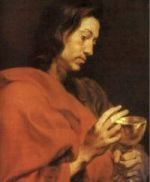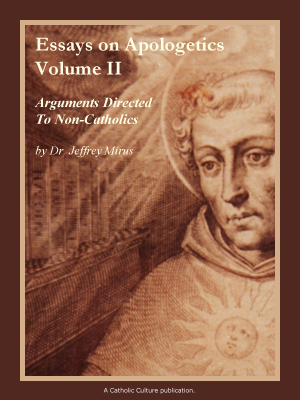Make your gift today!
Help keep Catholics around the world educated and informed.
Already donated? Log in to stop seeing these donation pop-ups.
Catholic Activity: Importance of Easter Customs
Mrs. McLoughlin discusses here the difficulty involved in celebrating Easter as surpassing all feast days, even the greatly commercialized Christmas holiday. In order to teach children of the great liturgical and salvific importance of Easter, she urges parents to implement many concrete customs and prayers in the home during this important feast. She includes a few examples of good Easter customs for the family.
DIRECTIONS
Eastertide, the season so rich in mystery between Easter and Pentecost, is the pinnacle of the liturgical year. The paths trod in longing through Advent to the summits of Christmas joy, to Epiphany, through the valley of Lent in contrition, and up the ascents of Passiontide, converge on the heights of Resurrection Day. The Feast of Feasts, it is a season of gladness, of hope, of joy: a season marked by Alleluias, in which there is no fasting or Office said on bended knee. The sublime glories of Christ's resurrection are commemorated by the Church for a week; the mysteries of Easter itself are celebrated as fifty "Sundays" until Pentecost has passed.
The joy of Easter is the joy of the risen Savior. We who have been spiritualized by the penance of Lent and reborn in the baptismal waters of Easter Night bear the impress of the resurrection upon our lives. For we who "were crucified with Him" and "were buried" have received from Him through Baptism the grace to "walk in the newness of life." Our spiritual resurrection begins with the renewal of our baptismal vows, our reincorporation into Christ by paschal Communion, and our fresh dedication to a truly Christian life during the Easter Vigil service.
Everything in the order of time and in the workings of the liturgy has been prepared for this feast. The story of Easter is written by Nature, God's handiwork, all over the earth in budding trees and blossoming flowers, in greening grass. Birds return in springtime to sing the carol of Easter. The symbolical "four thousand" years that followed the promise made by God to our first parents are crowned by this event. All that the Church has been doing since Advent has this glorious feast in mind.
Easter, the Anglo-Saxon word for April, owes its derivation to Eoster, a pagan goddess, according to St. Bede. In Butler's Moveable Feasts Easter derives from Oest, the Saxon word for rising; and from this comes Oesteren, the Resurrection.
As a word, Easter does not have a rightful place in Holy Scripture. The word which it seeks to translate is pasch. It means to spare or pass over, and commemorates God's sparing of the Hebrews whose doors were marked with the blood of the lamb, when He slew the first-born of the Egyptians.
The prelude to a truly happy Easter is an understanding of the mysteries of the Vigil service. Its beautiful Biblical imagery, its symbols of fire, light, water, wax, oil and incense relate to Abraham, Isaac, Noe and Moses, to the Red Sea, the pillar of fire and the paschal lamb.
Twelve years ago, before our first child was born, my husband and I decided that if we were to impress upon our family the great joy of Easter, we would have to celebrate it as the feast which surpasses all feasts, even "as the sun outshines all other planets." There is not the universal appeal about keeping the fifty days of Easter joy, nor is there the element of picturesqueness which surrounds Christmas. Most of all, there is no Baby who lays instant hold on our hearts as the center of the feast. We decided that we would find customs to suit us and use them with the liturgy, the official prayers which the Church has handed down to us as beautiful gems of pure poetry, polished through centuries of use. We felt that symbols, with the liturgy, would help to make concrete the theology of catechism and Bible for ourselves and our children.
In an encyclical on the liturgy, Mediator Dei, Pope Pius the Twelfth expressed his views on ceremonies or customs. "For although they do not in themselves contain perfection or holiness, nevertheless, they are the external acts of religion by which as by signs the soul is stimulated by the veneration of holy things, the mind is elevated to supernatural reality, piety is nourished, charity is inflamed, the faith is increased, devotion is made strong, the unlettered are instructed and the worship of God is made beautiful."
Suggestions:
Two years later, we added an Easter garden, which has a tomb (made from paper-mâché shaped and painted to resemble a cave or a shoe box and painted gray) with a arden and flowers, and dolls as tiny Marys, apostles and soldiers. On Easter morning the garden has all the fascination of the Christmas crib as we tell the story of the Resurrection using dolls.
As a family we had always used the largest Easter candle, or Lumen Christi, that we could find. When the children grew, they learned to mark it with five cloves in cross form, in memory of the five sacred wounds. The candle stands in a bowl of fresh cut flowers, tokens of new life.
Babies were rocked to Resurrection hymns and carols, a joy to baby, a relaxation to mother. The children grew and more simple hymns were added at family singing time. For the mother who is timid about singing or who might think we are a family of musicians, we must add that we have almost no musical training. But that does not stop us from singing for our enjoyment and the greater honor and glory of God.
There are two inexpensive booklets to which we owe many of our liturgical customs, Family Life in Christ by Therese Mueller, published by Liturgical Press, and A Candle is Lighted by P. Stewart Craig, published by the English Grail. In time we added Religion in the Home for the Pre-School Child by Katherine Delmonico Byles, published by the Paulist Press in New York, while not stressing the liturgy, emphasizes over and over the need of home altars and gives lists of songs for each season. In time we added Religion in the Home for the School Child by the same author, and an excellent set of pamphlets, Your Home, A Church in Miniature by Rev. Edgar Schmiedeler, O.S.B. The latter is published by the Family Life Bureau of the National Catholic Welfare Conference in Washington (Editor's Note: This pamphlet is now reprinted as Customs & Traditions of the Catholic Family by The Newmann Press.) An excellent guide for making the liturgy live in the home is Children of the Church by the Servants of the Immaculate Heart of Mary, Monroe, Michigan. This latter title gives suggestions not only for the Easter season but for the whole liturgical year. [CC Editor's Note: These pamphlets are out of print, but most of the information can be found on this website.]
Few symbols of resurrection catch the fancy of children as does that of the butterfly. Above all, the butterfly brings out clearly the idea of transformation or transfiguration; Christian resurrection is not resuscitation, it is a change to a nobler kind of existence. From the seemingly dead condition of the cocoon, a changed "supernaturalized(!)" life emerges. Children spontaneously get the implications.
Other customs were added gradually. Occasionally one which we tried did not suit. At other times we made our own customs. For instance, for Pierce, our older boy, now a pre-adolescent, we devised a Wreath of Victory, a symbol easy to understand. It is the prize won, as it were, for the long hard contest of Lent. In the words of St. Paul, "forgetting the things that are behind and stretching forth myself to that before, I press toward the mark, to the prize." Made on the Advent wreath form, the Wreath of Victory hangs in our living room during Eastertide. These customs, added to the prayers of the liturgy, help our children to realize that their song and prayer ascend to heaven with those of their elders "like the roaring of the waves of the sea, so that one in heart and one in mind, their uplifted voices signify that unity which befits brothers, who are sons of one Father."
We also use an Easter home shrine which has hand-made altar hangings or triptychs of the children's making, and as many flowers as we can afford to give the house an air of festivity that reflects Nature's resurrection in springtime. Easter bread and cake, baskets of eggs, the Agnellino, whole baby lamb for Easter dinner, await the paschal blessing by a priest or the father of the family. These customs in the words of Father Francis X. Weiser, S.J. in The Easter Book (Harcourt, Brace and Company, New York) help our family to make "the feast of Easter the climax of the liturgy." "Easter Sunday," he writes, "is a dazzling diamond that radiates the splendor of the Redemption and Resurrection into the hearts of the faithful everywhere. Its various facets cast the brilliance of eternity over the twilight of time, and enrapture the soul with the deathless pledge of a Second Spring."
Activity Source: Family Customs: Easter to Pentecost by Helen McLoughlin, The Liturgical Press, Collegeville, Minnesota, 1956






